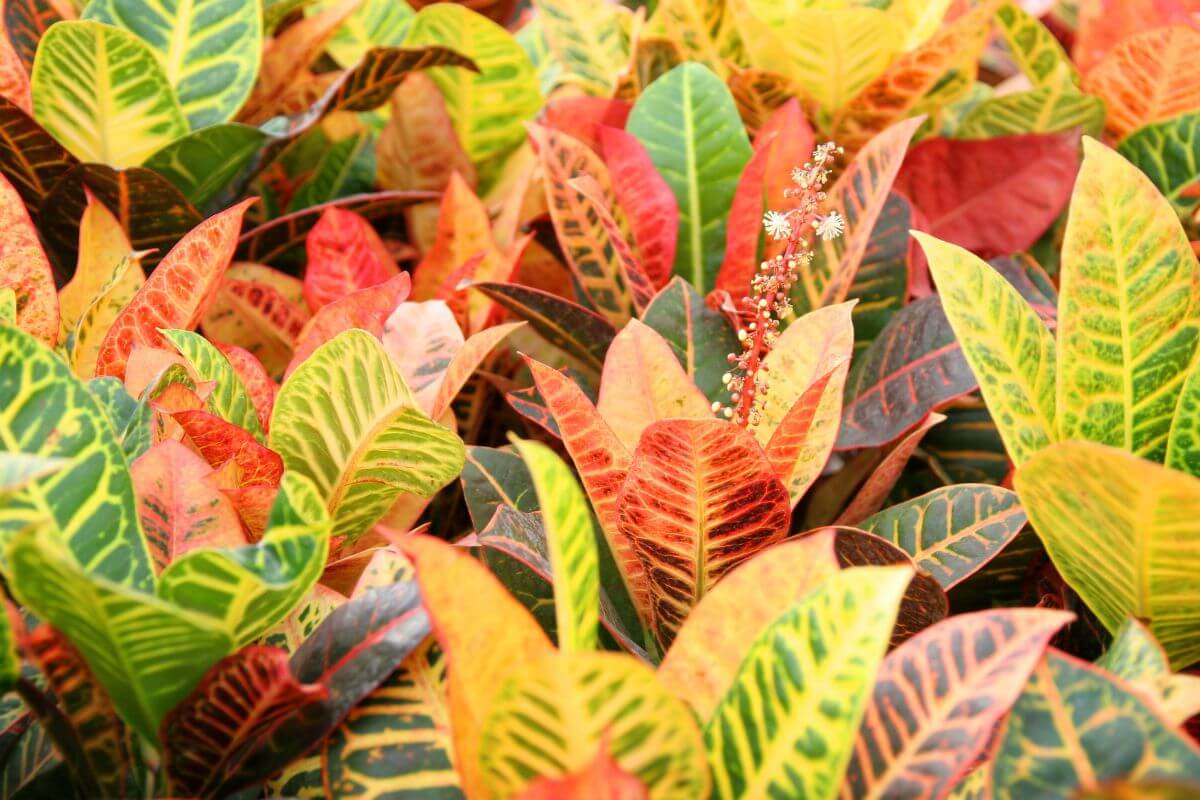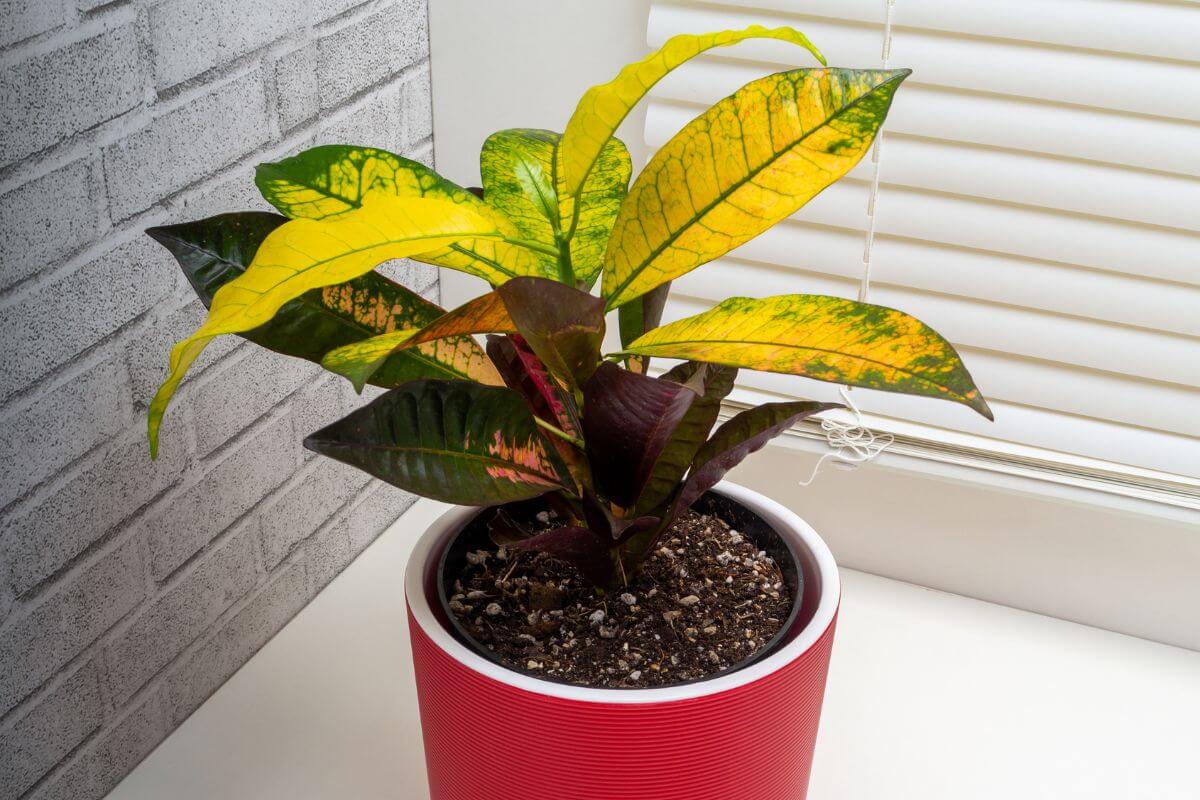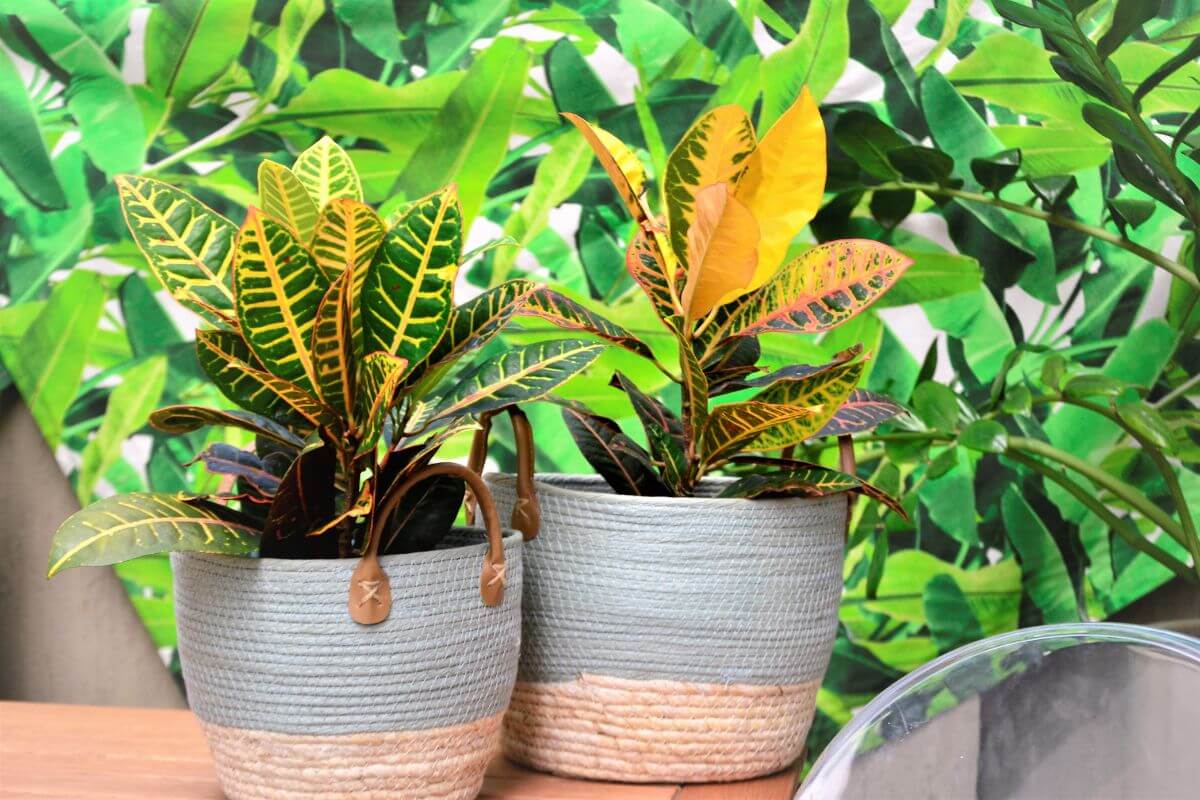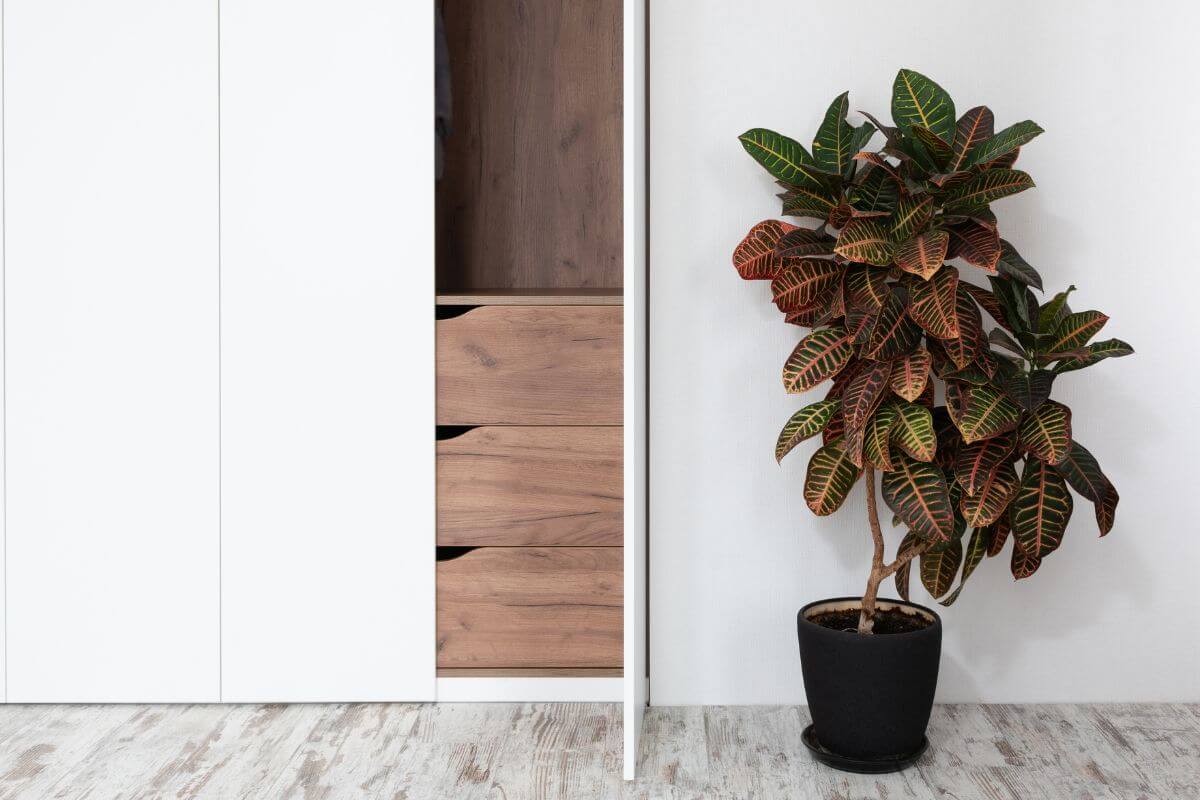The croton plant, otherwise known as the codiaeum variegatum, is a member of the Euphorbiaceae family and is a vividly colorful plant that will bring delight to any home or office.
With leaves that have multiple forms and colors such as red, yellow, and intense green, all it takes is one glance and you’ll want one.
If there is a diva in the indoor plant world, the croton has definitely earned this title. This lovely plant is quite difficult to please, especially if cultivated indoors.
The croton is a tropical plant and prefers a warm, humid environment with dappled or alternating light conditions, and plenty of water. The first challenge will be controlling the indoor temperature. If your house or office is cold, this plant will begin to shed leaves. But the bright color explosion is worth the effort.
Let’s get into how to care for the croton, so you can enjoy its beauty.
Croton Plant Overview

Croton plants are considered evergreen perennial shrubs, native to Malaysia and India. They do well when cultivated in areas like Hawaii, Porto Rico, and parts of coastal California. They can be found outdoors as ornamental shrubs in any number of properties.
The name “croton” originates from the Greek language. In Greek, croton means “tick” because its seed is in the shape of a tick.
The plant’s leaves are leathery in texture and come in many colors, shapes, and sizes. With age, it may darken enough to appear black.
Today, the plant is incredibly popular and enjoyed for their fantastic colors. In the past, an oil known as Croton tiglium from the croton plant was used as a purgative (laxative).
Crotons can grow to be ten feet in height when grown outside. Indoor potted plants will be much smaller.
If the outdoor temperature remains above 50°F, they can do well outside with the proper lighting. A mature plant can bloom with small flowers that look like bulbs with a star shape.
There are virtually hundreds of varieties of the croton, many with very original names such as:
- Mona Lisa
- Ann Rutherford
- Dreadlocks
- Irene Kingsley
- Eleanor Roosevelt
- Mammy Croton
- Banana Croton
- Zanzibar Croton
Considering the number of varieties, it is quite interesting that there is only a single species. However, crotons are genetically unstable, which makes every single plant unique. Some varieties are highly sought after by croton enthusiasts.
They are subdivided based on leaf shapes:
- Broad
- Curling
- Narrow
- Oak leaf
- Oval
- Twisted
Some of the more noteworthy croton plant varieties include:
- Codiaeum Variegatum Var Pictum: As a houseplant, this variety will grow anywhere from three to six feet. Its leaves are rather large and feature yellow, orange, red, bronze, purple, and green hues.
- Codiaeum Variegatum “Petra”: The Petra boasts oval-shaped green leaves with pink, orange, and yellow veins. It will grow from three to six feet tall.
- Codiaeum Variegatum “Gold Star”: This variety will feature linear, narrow leaves that are green with yellow spots. It will grow to about twenty inches in height.
Croton Plant Care
As a perennial, crotons that are well cared for should last for years. Even if a part of the plant dies in the winter, it will use the same roots to resprout in the spring.
Soil for the Croton Plant
Well-draining potting soil combined with peat moss is perfect for the croton. It should maintain moisture without retaining water. Croton plants should never be left to sit in soggy water-logged soil.
The ideal soil pH level is between 4.5 and 6.5.
Light for the Croton Plant

The croton’s vibrant leaf colors depend on the environmental light. Bright light exposure is appreciated.
Ideally, they need bright indirect light and not unfiltered direct sunlight. The lack of bright indirect light will negatively affect the color of the leaves and could lead to colors fading.
Temperature for the Croton Plant
The indoor environment should be kept above 60° Fahrenheit and below 80°F.
Keep the croton away from cold drafts like windows and doors. Also keep the plant away from heat sources, because either will shock the croton for short periods of time that will harm it.
Water and Humidity for the Croton Plant
During the growing season, summer and warmer months, water and mist frequently. In the winter, watering frequency can be reduced to once every two weeks.
Keep the soil moist. Be sure to test the soil from time to time. Make sure not to overwater as that can lead to root rot.
Crotons are not drought tolerant. The leaves will begin to wilt or drop if the plant lacks water or humidity. A lack of humidity will also affect the color of the foliage.
It’s a humidity-loving plant, so humidity should be maintained somewhere between 40 and 80 percent.
If you are unable to maintain this level of humidity in your home or office, run a humidifier in the room hosting the croton. You can also set a humidity tray underneath the plant and keep it grouped with other plants.
If your home or office suffers from low humidity, this will cause crotons to be susceptible to spider mites. You can mist the plant daily to avoid infestation.
Fertilization for the Croton Plant
Crotons can be fed a wide range of plant food. They prefer fertilizer that is high in both potassium and nitrogen.
If you are considering fertilizers that display their NPK (nitrogen-phosphorous-potassium) ratio, the middle number for phosphorous should be lower.
Good ratio options might be 3-1-2 or 8-2-10. Alternating between the two ratio types can be an effective solution, but much will depend on the soil.
The indoor croton is better fed with a liquid fertilizer during the growing season or slow-release fertilizing pellets can be used.
The initial feeding can be given in late February or early March. The second feeding in May, and a final feeding in the middle of July. Avoid fertilizing in the autumn as you may interrupt the croton’s preparation for the winter.
If you prefer to use a fertilizer regularly, give a light, diluted feeding once a month only during the growing season.
Croton Plant Pruning, Repotting, and Protection

Crotons respond very well to pruning and trimming. If you think your croton looks leggy, you can prune it back at the very beginning of the growing season and move it outside if temperatures permit.
The Croton will regrow where it has been pruned. Any dead branches or leaves should be cut back to their point of origin. Overgrown branches can be pruned to above a leaf set or node. Try not to cut away more than one-third of a stem at a time.
The croton should be repotted in the spring as needed. Use a new container that is one size larger than the actual pot it sits in. Here is how to repot the croton:
- Place approximately two inches of moist peat-based soil into the new pot.
- Place the croton plant on its side and gently move it out of the old pot by sliding it.
- Place it in the new container and fill in the space around the roots with potting soil.
- Water the plant and add in more potting soil to bring the soil level to approximately one inch below the new container’s rim.
- You can cease watering when it begins to drain from the bottom of the pot.
If the croton seems to be root bound, you can separate the roots gently with your fingers. If they are tight, use a gardening knife to score them. Continue with repotting.
If your croton is an outdoor plant, it will not do well in a significant frost. If your area’s temperature drops, consider covering the plant to protect it from frost.
Croton Plant Pests, Diseases, Problems, and More
If your croton appears to be losing leaves, there could be a number of reasons that the plant is becoming stressed. Here’s what you can do to revive it.
- Not Enough Light – It could be it’s not receiving enough light. Move it to a sunny location where it can receive 4 to 5 hours a day of sunlight.
- Extreme Temperatures – Make sure that the plant is not near drafts, either cold or hot, from windows, doors, air conditioners, or heaters.
- Overwatering or Underwatering – Check to see if it is receiving too much or too little water in its soil bed as watering is a common cause of leaf loss.
- Pest Infestation – Also, try gently cleaning the leaves to remove any pests.
- Nutrient Imbalance – Add plant food to give it more nutrients.
Crotons are pretty resistant when it comes to diseases and pests. They can however suffer from infestations of scale insects, thrips, mealy bugs, and spider mites.
Keep your eyes on the plant’s leaves for early signs of infestations. To remove these pests, you can use a cotton ball or pad with rubbing alcohol. Another option is to create your own organic pest spray.
Use two teaspoons of neem oil mixed with one teaspoon of dish soap and one quart of warm water. Place the mix in a spray bottle and spray the plant’s leaves generously every week until the pests are gone.
A final pest worth noting is the Achaea Janata or croton caterpillar. They devour the colorful leaves. Continuous applications of neem oil do reduce leaf consumption. Another option is BT or Bacillus thuringiensis that can be sprayed to eliminate these bugs. BT is harmless for pets, humans, and plants.
If left to sit in soggy soil, they are subject to root rot and may develop fungal or bacteria issues.
If you do not have a variety with twisting leaves, and your croton’s leaves begin twisting, this may indicate over-fertilization.
Croton Plant Toxicity and Pets

All parts of the croton plant are toxic to both pets and humans, through touch and ingestion.
The sap from the plant will cause skin irritation when touched, so it may be wise to wear gloves when doing cuttings or removing leaves. Any time that sap appears, you should be wearing a pair of gloves.
The ingestion of a small portion is considered moderately toxic. It will cause burning in humans and excessive drooling in your house pets.
The ingestion of large portions of the plant will lead to intestinal dismay culminating in diarrhea, stomach pain, vomiting, and nausea.
Pets that eat croton will appear tired or lethargic and unusually irritable. If the pet vomits, get it to the veterinarian immediately.
Propagating the Croton Plant
There are three ways to propagate the croton plant: stem cutting in soil, stem cutting in water, and air-layering.
Crotons can be propagated relatively easily with stem cuttings. You may want to use a rooting hormone to increase your chances of success. Crotons also may produce shoots or “sports” that are not directly connected to the parent plant. These can be removed and potted independently.
These plants do not grow well from seeds. The best option is stem cutting, especially if you want a plant similar to the mother plant.
A cutting intended for propagation should be three to four inches long and have three to five leaves on it. Dip it in rooting hormone, and it can be placed in a mix of vermiculite, peat moss, and sand.
It is important that the cutting is kept warm at a temperature ranging from 70° to 80°F . You will want to cover it to keep the humidity in until the roots form.
Once roots have developed, you can transplant it into potting soil. The soil should be kept moist.
You can also choose to place the cutting in a glass of water until the roots form. Crotons can also be divided at the roots of the parent plant that has outgrown its current container. It is risky though because this plant does not particularly enjoy being moved around too much.
A final option is referred to as air-layering. You will make a diagonal cut about halfway into the stem, however the stem should remain attached to the main plant.
Place rooting hormone into the wound. Use a toothpick to keep the cut open. Pack around the wound with moss (sphagnum) and wrap the area in plastic wrap. The moss must be kept moist.
If it browns, it needs water. Roots will form in the wound. When the roots form, you can cut the remainder of the stem and plant your new plant in its very own container.
Growing Croton Plant Final Thoughts
If you love color and want to brighten up your home or office, the croton is a perfect choice. Good light, warm temperatures and a dose of humidity will keep this lovely plant at her absolute best all year round.
Check out some of our other houseplant care and grow guides:
Growing Croton Plant FAQs
Do croton plants like full sun?
Croton plants love bright sunlight, but prefer it is indirect, so look for partial shade. Putting it in the sun for 4-5 hours a day will help give it some life if you see the leaves dropping. Lots of light will do wonders for it.
Why do croton leaves fall off?
Croton leaves will fall off for any number of reasons. The plant might not be receiving enough light, too much water or lack of water, sudden temperature or humidity changes, pest infestations, or a nutrient imbalance.
Does a croton grow fast?
The croton does not grow that fast. It can grow about one foot (12 inches) every growing season. They need lots of room to spread their beautiful leaves and blooms. If they get crowded, they won’t bloom properly. Crotons can grow from 3 to 10 feet and 3 to 6 feet wide.
Are croton plants easy to care for?
Croton plants are easy to care for as long as you know what to look for. Proper care includes watering them regularly to keep the soil moist. Make sure it gets plenty of light and humidity to allow it to flourish.
Is the croton plant poisonous?
Yes, the croton plant causes irritation when touched or ingested. Touching the croton’s sap can cause skin irritation. Ingestion can lead to stomach pains, nausea, diarrhea, and vomiting in pets and humans.
How do I make my croton bushy?
Make crotons bushier with regular pruning. Pinch off the smaller leaves as it will help encourage more leaf growth. Continue proper care with regular water, nutrients, light, pest control, and removing dead foliage.



